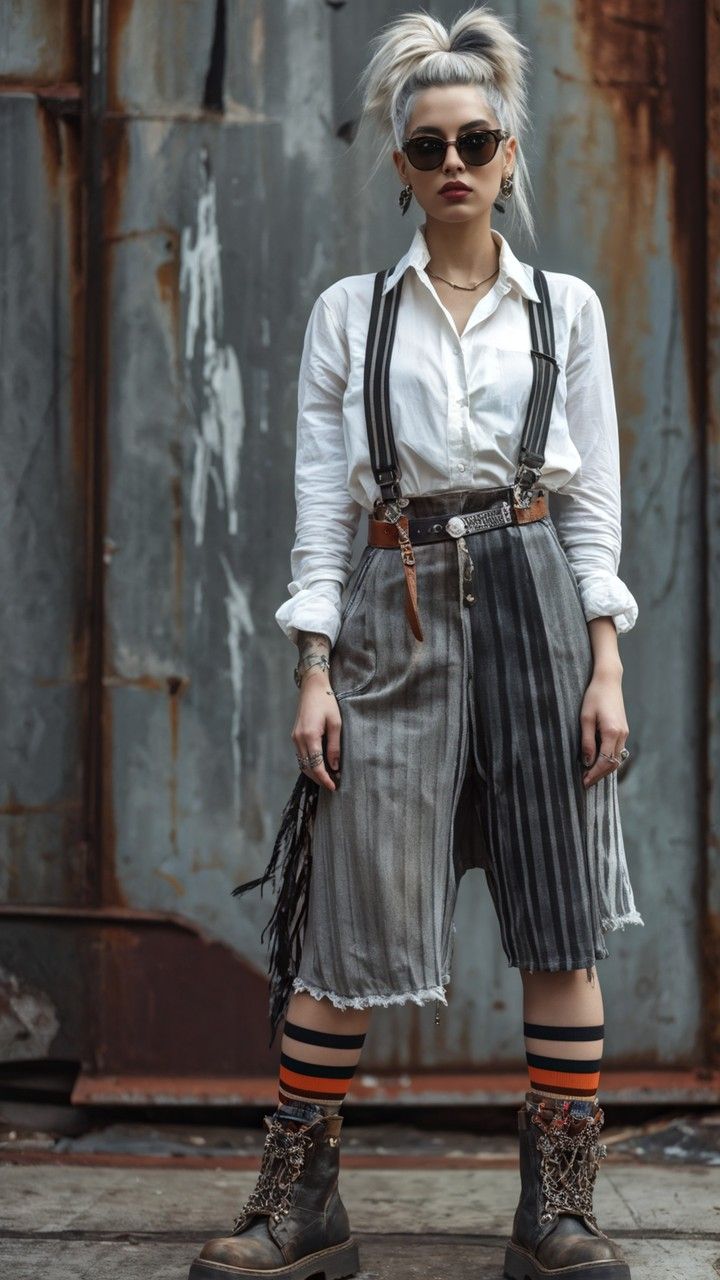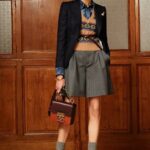Gothic & Punk Fashion: Rebellion, Expression, and Empowerment
Gothic and punk fashion are two distinct yet deeply interconnected styles that have become symbols of rebellion, nonconformity, and individuality. Both originated as cultural movements, reflecting discontent with mainstream society, and have since evolved into lasting subcultures that continue to influence fashion, music, and art worldwide. While each style has its unique elements, they both champion freedom of expression, creativity, and a rejection of conventional norms.
1. What is Gothic Fashion?
Gothic fashion is rooted in the dark, mysterious, and often macabre aesthetics that reflect the emotional and artistic undercurrents of the Gothic subculture. This style draws inspiration from the Gothic art, literature, and architecture of the 18th and 19th centuries, characterized by elements such as dark colors, intricate designs, and a sense of mystery.
Key features of gothic fashion include: Gothic and punk fashion
- Dark Color Palette: The hallmark of gothic fashion is its deep, dark hues. Black is the dominant color, but deep purples, reds, and blues are also common. The color scheme conveys a sense of darkness, melancholy, and mystery, aligned with the emotional depth of gothic culture.
- Victorian and Medieval Influence: Gothic fashion often incorporates elements from Victorian and medieval periods, including lace, corsets, velvet, and flowing skirts. These elements give the style a dramatic, old-world charm, often evoking a sense of timelessness.
- Leather, Fishnets, and Boots: Leather jackets, fishnet stockings, and combat boots are common in gothic fashion. These pieces add an edge to the otherwise elegant, somber look, creating a more punk-inspired twist on gothic attire.
- Accessories: Gothic accessories include silver jewelry, spiked chokers, crosses, ankh symbols, and skull motifs. These accessories often have spiritual or mystical connotations, reflecting the gothic subculture’s interest in the supernatural, the occult, and dark symbolism.
- Makeup and Hair: The makeup in gothic fashion is often striking and dramatic. Pale skin, dark eyeliner, bold lip colors like black, red, or deep purple, and exaggerated eye makeup are characteristic of the look. Hair is often dyed black or in dark shades, and styles can range from straight, sleek looks to more voluminous or wild hairstyles.
2. What is Punk Fashion?
Punk fashion emerged in the 1970s as part of the punk rock movement, which was an expression of anger, rebellion, and defiance against societal norms and mainstream culture. Punk fashion is all about making a bold statement, rejecting traditional aesthetics, and embracing DIY (do-it-yourself) culture.
Key features of punk fashion include:
- Distressed and Torn Clothing: Punk fashion is known for its ripped and torn clothing, often worn deliberately to show disregard for the polished, consumer-driven society. Leather jackets, band tees, and torn jeans are staples in punk wardrobes, contributing to the gritty, rebellious aesthetic.
- Studs, Spikes, and Chains: One of the most recognizable elements of punk fashion is the use of spiked collars, studs, and chains. These accessories were originally used to add an edge to the clothing, signifying rebellion and aggression.
- Bold Hair Colors and Styles: Punk hairstyles are often bold and unconventional. Mohawks, brightly colored hair (neon pink, green, blue), and spiked hairstyles are synonymous with the punk look. The idea is to reject mainstream beauty standards and to embrace personal expression.
- Boots and Combat Footwear: Heavy boots, such as Doc Martens or combat boots, are a key part of punk fashion. These shoes add to the toughness of the punk look and reflect the movement’s gritty, working-class roots.
- Political and Social Statements: Punk fashion has often been used as a tool for political and social commentary. Punk slogans, anarchist symbols, and political statements are often incorporated into clothing, highlighting the movement’s focus on activism and anti-establishment sentiments.
3. The History and Origins of Gothic and Punk Fashion; Gothic and punk fashion
Both gothic and punk fashion have deep cultural roots in the countercultures of the late 20th century.
- Gothic Fashion Origins: Gothic fashion emerged in the late 1970s and early 1980s alongside the Goth subculture, which grew out of the post-punk music scene. The music of bands like Bauhaus, Siouxsie and the Banshees, and The Cure heavily influenced the aesthetic of the goth movement, incorporating dark themes, atmospheric sounds, and introspective lyrics. As goth music gained popularity, the fashion evolved to match the genre’s somber, theatrical, and romantic style.
- Punk Fashion Origins: Punk fashion emerged in the mid-1970s, heavily influenced by the punk rock music scene. Bands like The Ramones, Sex Pistols, and The Clash were the soundtrack to a generation’s rebellion against political corruption, economic inequality, and societal expectations. Punk fashion was deeply influenced by the working-class youth who embraced a more raw, aggressive look. Punk designers like Vivienne Westwood and Malcolm McLaren played a pivotal role in shaping the fashion elements of the punk movement, using DIY techniques to create a new, anti-establishment aesthetic.
4. The Impact of Gothic and Punk Fashion on Society; Gothic and punk fashion
Gothic and punk fashion have had lasting effects on society and popular culture, and continue to shape trends today.
- Challenging Norms: Both styles reject the societal standards of beauty, dress, and behavior. They empower individuals to embrace their unique identities and to break free from the constraints of mainstream culture. Punk and goth fashion encourage people to express their inner emotions, whether it be anger, sadness, or a desire for freedom.
- Influence on Mainstream Fashion: Elements of both gothic and punk fashion have seeped into mainstream fashion over the years. The use of leather jackets, studs, and dark makeup has appeared in high fashion collections, and designers like Alexander McQueen have drawn inspiration from these subcultures.
- Social Activism: Punk fashion, with its anti-authoritarian ethos, has often been linked to political movements, while gothic fashion reflects the interest in the darker, more mysterious aspects of human existence. Both styles have provided a platform for social activism and the exploration of alternative lifestyles.
5. How to Embrace Gothic and Punk Fashion; Gothic and punk fashion
While these styles can appear extreme or difficult to adopt for those unfamiliar with them, there are several ways to incorporate elements of gothic and punk fashion into your wardrobe:
- Mix and Match: You don’t have to go full goth or punk to experiment with these styles. You can incorporate elements like leather jackets, chokers, or band t-shirts into your everyday wardrobe for a subtle rebellious touch.
- Layer Boldly: Both gothic and punk fashion allow for bold layering. Pair a plaid skirt with a leather jacket or a corset with a denim vest for an eclectic, punk-inspired look.
- Embrace DIY: One of the cornerstones of both subcultures is DIY culture. Customize your clothing with patches, studs, or even fabric paint to give your outfits a personal, rebellious touch.
- Accessorize: The right accessories can instantly elevate a gothic or punk look. Think spiked bracelets, bandanas, fingerless gloves, or metal necklaces to complete your ensemble.
6. The Significance of Gothic & Punk Fashion in Society; Gothic and punk fashion
Both gothic and punk fashion have made significant contributions to society by challenging conventional norms. They represent freedom of thought, individuality, and self-expression. These subcultures have provided safe spaces for people to explore their identities without fear of judgment. Moreover, they’ve empowered individuals to break away from mainstream expectations and adopt styles that are reflective of their personal beliefs, emotional states, and experiences.
Conclusion: Rebellion, Expression, and Identity; Gothic and punk fashion
Gothic and punk fashion are much more than just clothing choices; they are a means of self-expression and a tool for social commentary. These subcultures give a voice to those who feel marginalized by mainstream culture, allowing them to express their deepest emotions and beliefs through their appearance. While each style has evolved over time, the core themes of rebellion, individuality, and freedom of expression remain central to both gothic and punk fashion today. Whether you are drawn to the dark elegance of goth or the bold aggression of punk, these fashion styles provide a way to step outside societal norms and embrace your true self.











Beneficial content Regards!